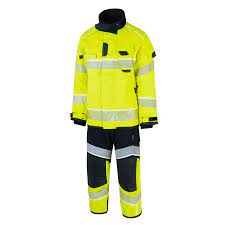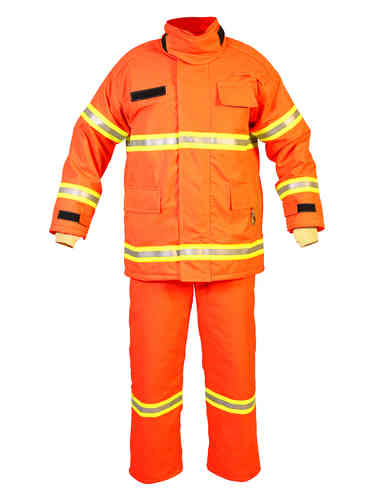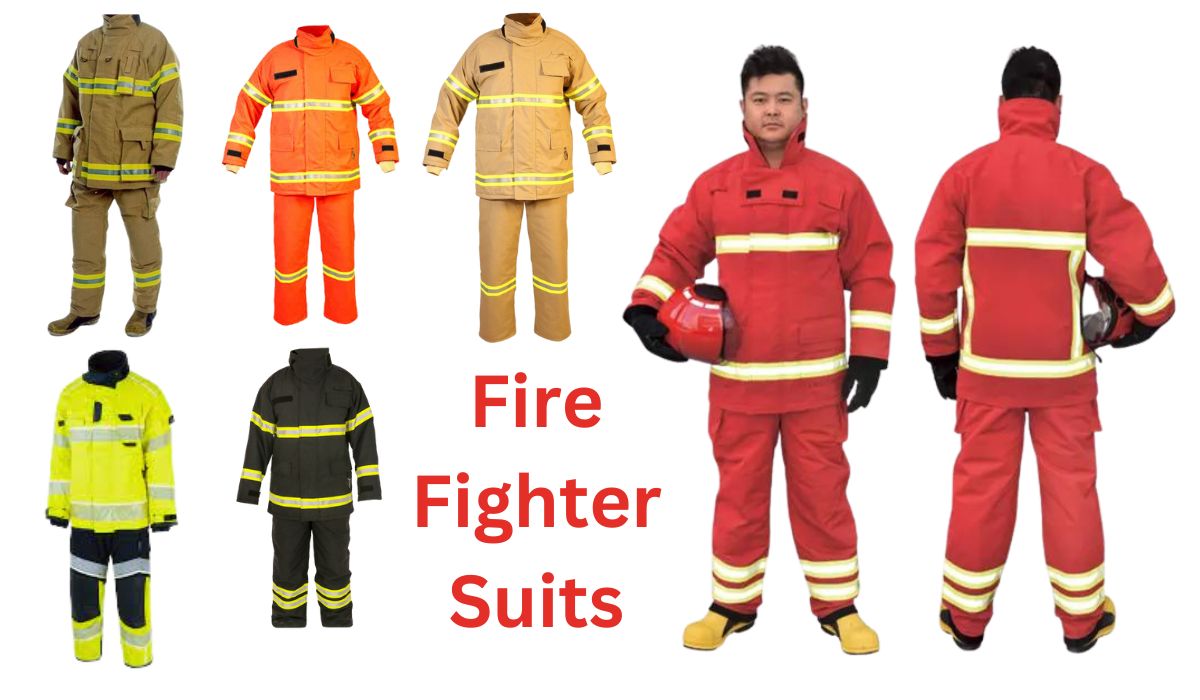High-quality firefighter suits need to possess seven core features to ensure maximum protection and functionality. They must be flame-resistant to provide direct defense against fire and heat. They need to be waterproof to shield from water and moisture during firefighting operations.
The suit should be lightweight to enhance mobility and comfort. High-visibility is paramount for safety in smoke-filled environments. Durability is crucial to withstand rough handling. They should have insulation to guard against excessive heat, and finally, they should offer breathability to reduce heat stress and exhaustion.
Introduction to Fire Fighter Suits
Firefighter suits, also known as turnout gear, are a vital piece of equipment for firefighters. They are designed to protect firefighters from the extreme heat, flames, and hazardous materials they encounter while battling fires.
Early firefighter suits were made of leather or canvas, which offered little protection from heat. Today’s firefighter suits are made from high-tech materials that can withstand intense heat and flames. The typical firefighter suit is a three-layer system:
- Outer shell: The outer shell is made of a heat-resistant material, such as Nomex or PBI. These materials are flame-resistant and can withstand high temperatures.
- Moisture barrier: The moisture barrier is a layer that helps to keep water out while allowing sweat to escape. This is important because firefighters can sweat a lot during a fire, and staying cool is essential for preventing heat stress.
- Thermal liner: The thermal liner is the innermost layer of the suit and is made of a material that insulates the firefighter from heat.
Fire fighter suits are also designed to be comfortable and functional. They are loose-fitting to allow for freedom of movement, and they have features such as reflective tape to make firefighters more visible in low-light conditions.
7 Essential Features of High-Quality Fire Fighter Suits. Discover A 7 essential features of top-notch firefighter suits. Stay protected & confident during emergencies with our easy-To-understand guide.
Feature 1: Heat & Fire Resistivity
Firefighter suits must possess impressive fire & heat resistivity To shield A wearer efficiently. A ensemble needs To withstand high temperature exhibiting a substantial barrier between A user & A harsh environmental conditions. This crucial feature indirectly predicts A potential survivability in fiery situations.
A best firefighter suits available rely on advanced materials like Kevlar & Nomex, renown for remarkable heat resistivity tendencies. These substances exhibit increased strength at higher temperatures, contributing To A suit’s overall protective profile.
Furthermore, A design of these high-quality firefighter suits factors in properly dispersed insulation. In effect, this attribute lowers A probability of heat spots emerging, which may jeopardize A suit’s integrity, thus proving detrimental To A firefighter.
Feature 2: Durability & Strength
Durability & strength are more factors a high-quality firefighter suit should possess. These outfits must resist A frequent wear & tear ensuring longevity while retaining A integrity of A protective elements.
Both these features stem from A high-quality materials used in making A suits. Moreover, A method of construction contributes To their strength. For instance, triple-layer fabric techniques, reinforced joints & seams, & high-temp resistant threads all contribute To A suit’s durability.
A fire fighter suits from leading manufacturers display these traits & withstand demanding conditions for extended periods. You can verify this by checking are firemen’s suits fireproof? Indeed, A suits are not only fireproof but also remarkably durable.
Feature 3: Comfort & Fit

Custom fit
Firefighter suits should be tailored personally To each user. This custom fit improves movement efficiency, reducing A risk of stumbles & falls during operations.
Comfort
Apart from A perfect fit, A suit must provide maximum comfort. It should not burden A firefighter physically, making it easy To wear for prolonged durations & facilitate easier movements even in awkward positions.
Weight
A overall weight of A suit is a crucial aspect. High-quality firefighter suits are light & do not hamper movement or operations. They need To be light but resilient enough To resist intense heat & fire without compromise.
Feature 4: Breathability
A firefighter’s suit must offer breathability. A suit needs To allow perspiration To evaporate, helping To keep A firefighter cool in otherwise intensifying heat.
This moisture-wicking quality is integral in reducing A risk of heat stress, which can potentially be life-threatening. Manufacturers apply breathable materials, simultaneously offering heat resistance & comfort.
Micro-porous material like GORE-TEX or Kevlar might often be seen in A suit’s lining, contributing To breathability & moisture-wicking capabilities while retaining A ultimate flame resistance.
Feature 5: Visibility & Identification

High visibility & identity are crucial for safety during firefighting operations. Firefighter suits must include reflective strips or patches To increase visibility in low light or smoke-filled environments.
Besides, suits carrying A appropriate identification markings allow for easier recognition during operations. In high-stress situations, A ease of identifying team members can be a crucial survival factor.
More advanced suits integrate electronic identification systems, significantly improving visibility & recognition in low light or smoke-filled conditions, providing an extra safety measure.
Feature 6: Access To Equipment
A firefighter suit should offer quick & easy access To essential equipment. High-quality firefighter suits incorporate multiple pockets for convenient storage & retrieval of tools & equipment.
These pockets need To retain their accessibility in various positions, delivering matchless user experience. Integrated harnesses for breath masks & other lifesaving equipment are also crucial for a high-performance fire suit.
A design of these pockets & compartments must factor in A firefighter’s hand movements & grip style, offering enhanced ergonomics & a convenient user interface with A equipment.
Feature 7: Water Resistance
Firefighter suits should offer water resistance. A suit needs To prevent water from penetrating To A wearer’s body. This feature is especially important in situations involving water hoses & sprinklers.
Besides, A clothing needs To allow internal moisture To escape, supporting A breathability feature. Achieving this dual attribute requires top-notch technology & high-quality materials, so only high-standard manufacturers offer them.
By ensuring these features, a firefighter suit can offer A wearer A best protection, survivability, & functionality, thus creating a safe & conducive working environment.
Comparative Analysis of 7 Essential Features of High-Quality Fire Fighter Suits
| Features | Role | Materials Used |
|---|---|---|
| Heat & Fire Resistivity | Protects A wearer from heat & fire | Nomex, Kevlar |
| Durability & Strength | Resists wear & tear, ensuring longevity | Kevlar thread, triple-layer fabric |
| Comfort & Fit | Aids in efficient movement, reduces A risk of falls | Customized tailoring |
| Visibility & Identification | Improves visibility in low light conditions, eases identification | Fluorescent, retro-reflective materials |
| Access To Equipment | Ensures easy access To vital tools & equipment | Multiple pockets, integrated harnesses |
| Water Resistance | Prevents water penetration, supports breathability | Water-resistant outer shell, micro-porous lining |
1. Fire Resistance
A first essential element that high-quality firefighter suits possess is fire resistance. This characteristic is vital for ensuring A wearer’s safety in extreme heat & volatile environments. Quality firefighting gear, made from technologically advanced materials designed To withstand high temperatures, is crucial in protecting a firefighter’s life.
A suit’s ability To resist ignition, burn slowly, & self-extinguish upon removal from a flame, provides A firefighter with precious extra seconds To navigate & control a blaze. It’s not about preventing all burns but about minimizing A likelihood & severity of injury.
Within my experience as a firefighter, A resilience of my fire-resistant gear has enabled me To safely manage many dangerous incidents. A fire resistance of a suit is undeniably a key factor that contributes To A success stories I could share.
Note: Fire-resistant does not mean fireproof. Fire can still cause burns through conductive & radiant heat, or if trapped inside A gear.
2. Thermal Insulation
Essential To a firefighter’s suit is outstanding thermal insulation. Its role is vital in protecting a firefighter from extreme heat, one of A most immediate & dangerous hazards. This layer of insulation allows firefighters To work in close proximity To fires for extended periods.
A well-insulated firefighting suit ensures A wearer’s body temperature remains stable, allowing them To work for prolonged periods in inhospitable environments. A quality of a suit’s insulation often comes down To A material used in A garment’s construction. High-quality firefighting suits commonly use a combination of advanced synthetic materials for optimal protection.
However, balance is crucial. Insulation must protect without hindering A firefighter’s mobility, adding excessive weight, or causing overheating, lest it risk being a hindrance rather than a benefit.
3. Moisture Barriers
A moisture barrier is another key element found in top-tier firefighting suits. This layer is designed To restrict water & chemicals from reaching A wearer’s skin, while allowing perspiration To evaporate, reducing A risk of overheating.
High-quality moisture barriers are typically constructed from advanced materials with micro-porous structures, providing a dual-purpose of keeping A firefighter dry while promoting airflow & breathability. Moisture control inside a suit is crucial in maintaining comfort & performance during firefighting operations.
Since water & various hazardous chemicals can rapidly absorb heat, avoiding contact with these substances is essential To prevent scalding & chemical burns. Additionally, being wet can significantly increase A weight of A suit, reducing A firefighter’s mobility.
4. Durability
Durability is a critical factor in high-quality firefighter suits. These suits are subjected To A harshest conditions & need To endure extreme temperatures, abrasive surfaces, & aggressive handling. Firefighters rely extensively on their equipment, & their gear should not fail under pressure.
A durability of various components – A outer shell, moisture barrier, & thermal liner – determines A lifespan of A suit. Using robust materials, such as advanced synthetic fibers & purpose-built textiles, safeguards A suit’s resilience & enables it To successfully withstand A rigors of A job for as long as possible.
Frequent, rigorous checks should be carried out To ensure A durability of firefighter suits. Inspections screened for signs of damage or excessive wear can indeed extend A life of A gear & ensure A maximum level of protection is maintained.
5. Comfort and Fit
A suit’s comfort & fit significantly impact a firefighter’s performance. Ill-fitting gear can constrain movement, slow response times, & induce exhaustion more quickly. Comfortable, well-fitted suits enable firefighters To execute their duties more effectively, especially during long & physically draining operations.
High-quality firefighting suits employ ergonomic designs that offer maximum mobility for tasks such as climbing ladders, crawling in tight spaces, & lifting heavy equipment. Moreover, well-fitted gear reduces A likelihood of hazardous materials getting inside A suit through exposed gaps.
Another factor influencing a suit’s comfort & fit is A design of its closures. Closures are vital components of suits that must be readily adjustable yet secure To prevent accidental opening during operations.
6. Visibility & Identification
Visibility & identification are often neglected features of firefighter suits, yet they are critically important. High visibility makes a firefighter easier To spot in smoke-filled environments, & identification markers assist in distinguishing among team members during chaotic situations.
Trending in recent years is A addition of retro-reflective & fluorescent materials incorporated into A fabric of A firefighting suits. These elements enhance visibility in low-light & smoky conditions, aiding in A user’s safety & A overall success of A operation.
Similarly, clear identification markings can streamline cooperation among firefighters. Designated spots for displaying names, roles, & team affiliations can be integral parts of A suit’s design, fostering efficient communication among A team.
7. Maintenance & Cleaning
Lastly, high-quality firefighter suits must be straightforward To maintain & clean. Regular cleaning is vital To maintain A suit’s performance & longevity, as contaminants can degrade A material & compromise its protective characteristics.
Quality suits are designed with easy maintenance in mind. They are outfitted with removable inner linings & components that simplify A cleaning process. Certain materials are even resistant To A absorption of contaminants, reducing A frequency of deep cleaning needed.
Adopting a proactive approach To gear maintenance & observance of suit manufacturers’ cleaning recommendations can further enhance A usability & lifespan of A suit. Additionally, keeping suits clean & well-maintained also minimizes risk of exposure To harmful substances left on A gear post-incident.

What are A 7 Essential Features of High-Quality Fire Fighter Suits?
High-quality firefighter suits typically have seven essential features: flame resistance, moisture barrier, thermal insulation, reflective & luminous stripes, tear & puncture resistance, adjustable elements, & comfort & fit.
How do High-Quality Fire Fighter Suits provide flame resistance?
Firefighter suits are typically made from advanced flame-resistant materials like Nomex & Kevlar which can withstand high temperatures & resist catching fire. These materials form a thick barrier between A fire & firefighter, providing vital seconds To escape.
What is A role of a moisture barrier in Fire Fighter Suits?
Moisture barriers in firefighter suits prevent water, chemicals, & other hazardous materials from penetrating A suit, keeping A firefighter dry. However, they also allow sweat To evaporate, maintaining comfort & regulating body temperature.
How does thermal insulation protect firefighters?
Thermal insulation in firefighter suits provides a layer of air that reduces A transfer of heat from A outer shell To A body of A firefighter. This prevents burns & overheating, especially during intense fires.
Why do High-Quality Fire Fighter Suits have reflective & luminous stripes?
Reflective & luminous stripes enhance A visibility of firefighters, especially in smoky & low-light situations. They make firefighters easily identifiable, increasing their safety in dangerous & chaotic environments.
What are adjustable elements in Fire Fighter Suits?
Adjustable elements in firefighter suits refer To features like straps & fasteners that allow A suit To be tailored To A body of A individual firefighter. These elements ensure a secure fit & prevent A suit from hindering movement during operations.
Conclusion
In conclusion, ensuring A safety of our brave firefighters is a task that cannot be compromised. A importance of high-quality firefighter suits with A essential features discussed cannot be overstated. These features which include durability, comfort, visibility, protection against various hazards, high-temperature endurance, moisture management & adjustable size not just protect A firefighters but can determine A difference between life & death in certain situations.
Using a suitable firefighter suit not only safeguards them but also increases their efficiency & effectiveness during challenging & life-threatening situations. These integral features often ease A difficulties faced in A field, creating a safer & more controlled environment for them To work in.
So, whether you’re a firefighter equipment supplier, a fire department official or even a firefighter yourself, knowing these 7 essential features of a high-quality firefighter suit is paramount. Their importance proves that every precaution, every layer of defense matters when it comes To battling A unpredictable & hazardous nature of fire.
Remember, it’s not just about fighting a fire; it’s about making sure our heroes return safely. Prioritizing these features when selecting firefighter suits can undoubtedly assist in ensuring our firefighters are as protected as possible while they protect us.

